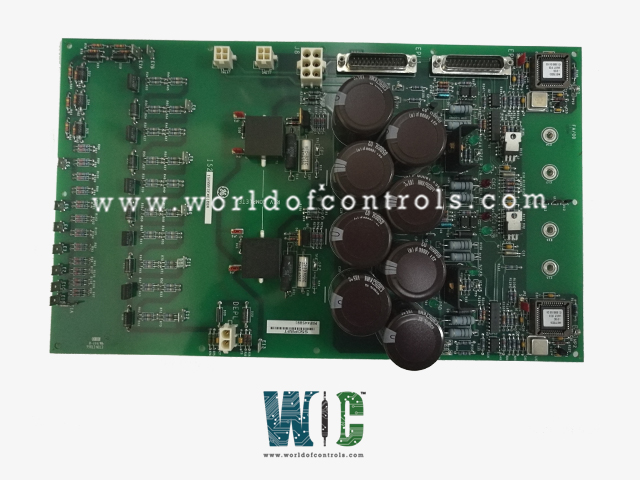
World Of Controls understands the criticality of your requirement and works towards reducing the lead time as much as possible.
IS200EDEXG2A - Exciter De-Excitation Control Board is available in stock which ships the same day.
IS200EDEXG2A - Exciter De-Excitation Control Board comes in UNUSED as well as REBUILT condition.
To avail our best deals for IS200EDEXG2A - Exciter De-Excitation Control Board, contact us and we will get back to you within 24 hours.
SPECIFICATIONS:
Part Number: IS200EDEXG2A
Manufacturer: General Electric
Series: EX2100e
Product Type: Exciter De-Excitation Control Board
Number of channels: 12
Input span: 4-20 mA
Technology: Surface Mount
Common Mode Voltage Range: ±5 V
Maximum Lead Resistance: 15Ω
Analog output current: 0-20 mA
Operating temperature: -30 to 65 °C
Size: 8.26 cm high x 4.19 cm
Repair: 3-7 Day
Availability: In Stock
Country of Origin: United States
Manual: GEI-100466
FUNCTIONAL DESCRIPTION:
IS200EDEXG2A is an Exciter De-Excitation Control Board manufactured and designed by General Electric as part of the EX2100e Series used in GE Excitation Control Systems. The IS200EDEX Exciter De-Excitation control board (EDEX) is the main board in the de-excitation module. This module removes stored energy from the generator field when an emergency shutdown occurs and the field breaker or contactors open. EDEX provides SCR firing, conduction sense feedback, and voltage retention to ensure operation in the event of a power failure. EMIO initiates de-excitation on the EXTB board. The EXTB board opens the 41dc contactor (MDA/MDB) or breaker and then transfers de-excitation signals from the auxiliary contacts to SCR firing circuits on the EDEX. The control scheme is shown in the following diagram. There are two types of EDEX boards. Group 1 is designed for SCR de-excitation, and Group 2 is designed for diode de-excitation.
FEATURES:
Upon firing, the circuit produces a high-frequency square wave which is connected to the SCR gate and causes conduction. If this circuit fails or is delayed, a self-firing circuit fires the gate. This circuit consists of a break-over diode network controlled by the SCR anode voltage, and connected to the SCR gate.
EDEX retains voltage on the positive 24 V dc and negative 24 V dc so it can fire the SCR in the event of a total power failure. Voltage for wetting the external de-excitation contacts is also provided by the voltage hold up circuitry. This ensures the firing command is available for de-excitation after a power failure.
EDEX detects current in the field circuit using Hall Effect sensors. A mechanical ring couples magnetic flux to the sensors located at the top edge of the board. Both sensor circuits 1 and 2 have separate circuits detecting bi-polar current flow. The M1 and M2 current sense signals are sent to EXTB and then to control.
The SCR anode firing voltage is selectable for the voltage and type of SCR used. Both the Break Diodes (BODs) and current limiting resistors are set with wire jumpers. The firing commands M1, M2, and the Break Over Diodes, are wired together and connected to the gate of the SCR through the DEPL connector.
For large field current applications, it is necessary to use multiple de-excitation SCRs. Each SCR is controlled by an EDEX board connected in a Master-Follower configuration. The figure below shows the connections.
Stab connectors E1B through E12 are for wire jumpers to select the breakover diodes and current limiting resistors for the voltage and size of SCR. Stab connector E1A is wire-jumpered to the SCR anode.
WOC has the largest stock of GE Excitation Control System Replacement Parts. We can also repair your faulty boards. WORLD OF CONTROLS can also supply unused and rebuilt backed-up with a warranty. Our team of experts is available round the clock to support your OEM needs. Our team of experts at WOC is happy to assist you with any of your automation requirements. For pricing and availability on any parts and repairs, kindly get in touch with our team by phone or email.
What is an Exciter De-Excitation Control Board?
An Exciter De-Excitation Control Board is a component in electrical systems that controls the excitation of a generator. The excitation system is responsible for providing the necessary magnetic field to generate electricity in the generator.
What is the purpose of the Exciter De-Excitation Control Board?
The primary purpose is to regulate the excitation level of the generator's field winding, ensuring stable and controlled power output. The de-excitation function is crucial for safely reducing the generator's output when needed.
How does the Exciter De-Excitation Control Board work?
The control board monitors the electrical parameters of the generator, such as voltage and frequency. It adjusts the excitation level by controlling the field current, and maintaining stable operating conditions. During de-excitation, it reduces the excitation to decrease power output.